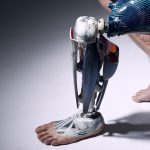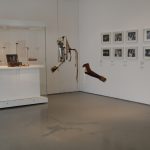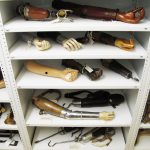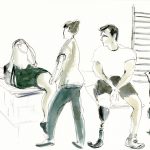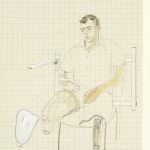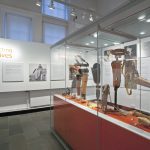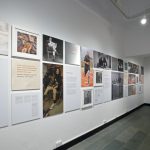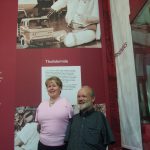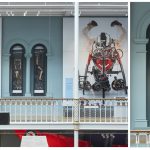Prosthetic limbs on display: from maker to user
Article DOI: https://dx.doi.org/10.15180/170806
Abstract
Prosthetic devices have been used in museums to tell clinical, technical and personal stories. Here we reflect on the ways artificial limbs and their users were represented in recent museum projects at the Royal College of Surgeons of England and at National Museums Scotland. We consider how these meaningful artefacts illuminate three overlapping themes in museum scholarship and practice: the representation of disabled people and disability in museums; reflections on conflict-acquired limb loss; and the presence or otherwise of user or patient voice in interpretation. In working with and representing people who design and wear prosthetics we advocate a balance between narratives of technique and of use.
Keywords
disability, prosthetics, users, war
Introduction
https://dx.doi.org/10.15180/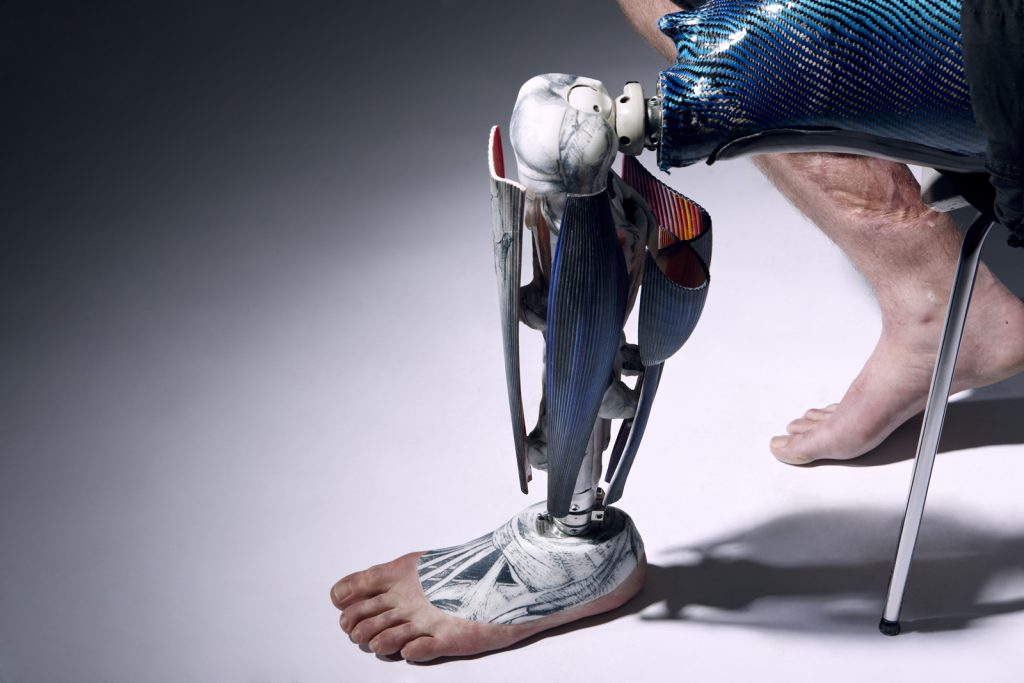
Consider the object in Figure 1. It appears to be part human, part skeleton, part robot. It’s an uncanny, hybrid lower leg. The toes, sole and heel are hyper-real silicone imitations of the other foot, unnerving in their verisimilitude. The upper foot, tibia and knee feature an anatomical motif; the muscle plates and thigh socket have a playful, futuristic twist in their design. This is a prosthetic limb crafted for ex-serviceman Ryan Seary by sculptor-turned-prosthetist Sophie Oliveira Barata as part of ‘The Alternative Limb Project’. The realistic toes are to allow Seary to wear sandals; the shell of the calf gives shape under trousers; but the overall aesthetic was an imaginative intervention by artist and client. Seary explains:
My team were carrying out a high-risk search in Babaji, Helmand [in 2010]. Whilst on the route I stepped on [an improvised explosive device], it partially detonated which removed my left foot and hand at the scene. […] At Bastion my left leg was removed above the knee and my left arm above the elbow. […]
My expectations of the leg were high as I have seen Sophie’s other work and she is a very talented artist. When I received the leg it was better than I could have imagined, it can only be described as Awesome! The detail is amazing and I can’t get over how realistic the foot looks, many people have taken a few seconds to get their mind round the fact that it’s not real.
Three important contemporary issues in museums and wider scholarship intersect in the ‘Anatomical Leg’, an image of which features in the interpretation in the Technology by Design gallery that opened in 2016 in the National Museum of Scotland.
Firstly, it materialises the practical and critical work around the representation of disability in museums over the last decade or so. A trajectory within the sector can be traced from revealing hidden histories (Delin, 2002; Sandell et al, 2005; Telfer, Shepley and Reeves, 2011) to dedicated exhibitions and projects (Gosling, 2012); it should now be the case that disability is incorporated across museum practice as a matter of course. From accessibility in new builds as embedded in the UK Equality Act (2010) to displays like Technology by Design, heritage organisations are beginning to weave disability across their work, as they do other human characteristics that fall under the clumsy banner ‘equality and diversity’.
Secondly, the leg is one of many manifestations of conflict-acquired limb loss in museums and galleries, especially (though not exclusively) as part of the commemorations of the First World War centenary between 2014 and 2018. Exhibitions and programming have innovatively engaged with the material culture of injuries past and present and introduced the damaged body of the soldier into museums where they had too often been absent (Carden-Coyne, 2010). The Body Extended: Sculpture and Prosthetics at the Henry Moore Institute (displayed 2016; see Figure 2) juxtaposed historic devices with sculptural equivalents and responses; First World War prostheses also featured in the Science Museum’s Wounded: Conflict, Casualties and Care (on display 2016–18; Emmens, 2016).
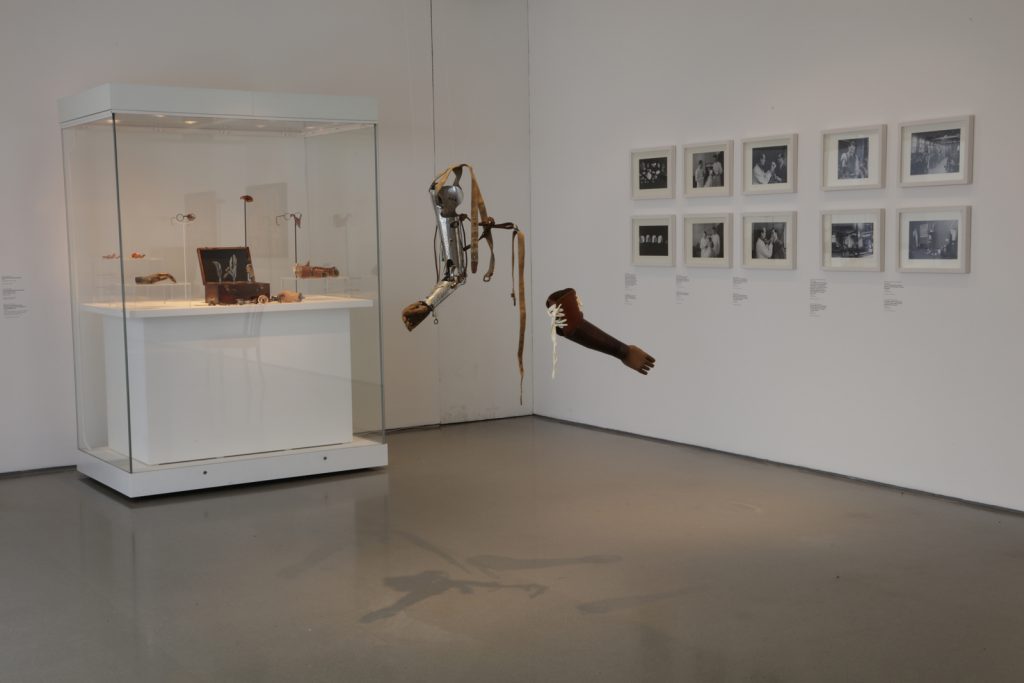
Finally, Seary’s and other devices in Technology by Design exemplify an enhanced representation of patients and other users in museums of science, technology and medicine. Whereas museum narratives have historically been dominated by clinicians and inventors, we now see more evidence of those who experienced techno-medical innovations (Alberti, 2016). Just as patient agency permeates healthcare provision, so too we see more patient stories and voices in medical museums such as the Berlin Museum of Medical History at the Charité (especially in its historical patient ward, displayed since 2007; (Schnalke, 2013) and projects such as John Wynne and Tim Wainwright’s Transplant (which began in 2006; see Hume, 2008). This resonates with attention to users in academic fields like science and technology studies (Corn, 2011; Oudshoorn and Pinch, 2003); and, crucially, the history of use also encourages representation of non-use, as we shall see below.
Here we seek to swim with these currents by considering recent projects in UK museums involving the display of prosthetic limbs and their interpretation in two and three dimensions. Engaging with both military and civilian situations we consider the balance between medico-technical narratives of invention/cure and accounts of those who experience these devices. As such we consider whether they implicitly subscribed to either or both of two models of disability. Activists and scholars have identified a medical model in which disability is framed as a physical and/or biological deficit, a clinical problem to be fixed. This is contrasted with a social model that asserts disability (as opposed to impairment) is constructed by societal boundaries and attitudes (Shakespeare, 2016). Richard Sandell and others have explored the implicit and explicit application of these ways of understanding disability in museum contexts in the 2000s (Sandell and Dodd, 2010; Anderson and O’Sullivan, 2010). They showed museums to be sites of encounter between disability politics, museum stakeholders and visitors in varying degrees of harmony and contest. Here we consider efforts to balance different approaches in the 2010s.
We ourselves have been among those involved in the efforts we discuss. Within a historical and museological framework, this piece therefore includes an element of critical reflective practice (Bolton, 2010; Lynch, 2011; McCarthy, 2015), drawing on our experiences since 2011 at the Royal College of Surgeons of England and National Museums Scotland. The former includes the Hunterian Museum in London, based on the collections of John Hunter (whose older brother William seeded the Hunterian in Glasgow); the latter involves five sites including the National Museum of Scotland and the National War Museum of Scotland in Edinburgh.
In our work at these institutions we were by no means the first to have displayed prosthetic limbs and their use, of course. It may be that ‘as social objects with a complex set of meanings in the daily lives of people’ prosthetics ‘have rarely, if ever, been understood as part of vernacular material culture’ (Ott, 2002, p 2). Yet even if we only consider Anglophone predecessors, it is clear the projects below build upon a long history of collecting and exhibiting. Artificial limbs have been gathered by collectors as curiosities, and nineteenth-century medical collections such as the Mütter Museum in Philadelphia and the Army Medical Museum in Washington DC featured military prosthetics. After their tragic expansion of use during the First World War artificial limbs were exhibited as propaganda (Reznick, 2004). Meanwhile, Henry Wellcome’s voracious collecting inevitably included prosthetics (Arnold and Olsen, 2003; Larsen, 2009); these are now housed by the Science Museum alongside an extraordinary collection from the specialist Queen Mary’s Hospital in Roehampton (Emmens, 2010; see Figure 3). The National Museum of American History’s Division of Medicine and Science also has an important collection which has been used in pioneering projects such as ‘EveryBody: An Artifact History of Disability in America’ (Ott et al, 2013).
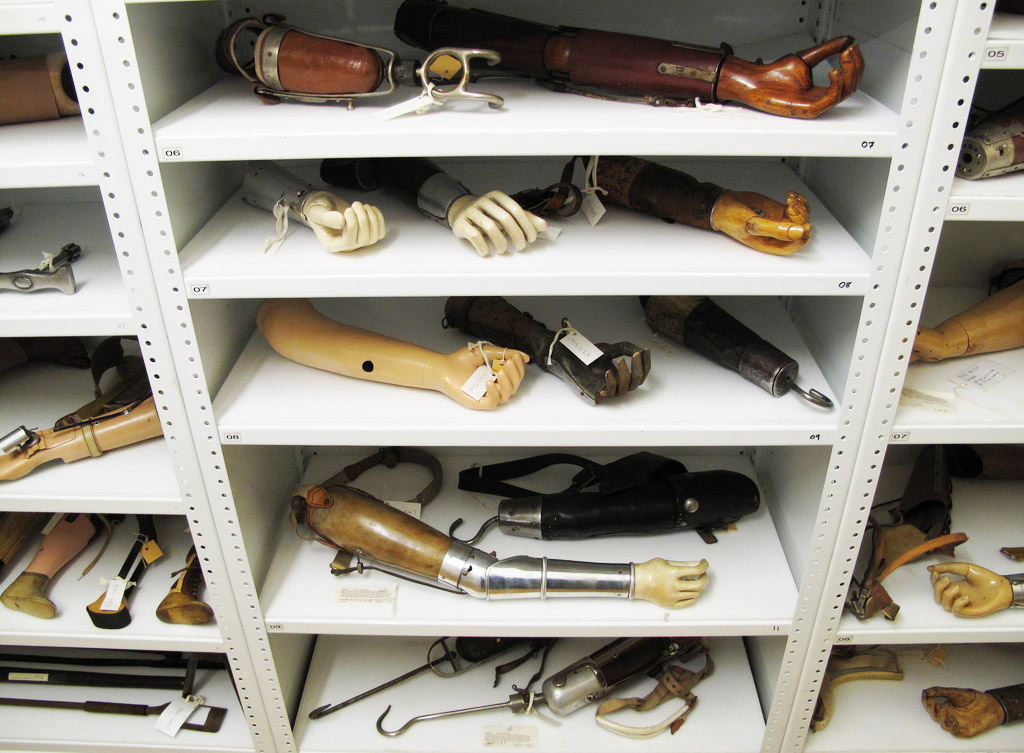
Against this background we worked on projects in London and Edinburgh that represented prosthetic limbs and the designers, clinicians and users associated with them. First, we discuss War, Art and Surgery, staged at the Hunterian in 2014. Then we reflect on a series of linked exhibits in National Museums Scotland sites in Edinburgh: Reconstructing Lives (2012) at the National War Museum, then Shaping our World (2011) at the National Museum of Scotland, where we remain to consider Technology by Design, part of a suite of new permanent galleries which opened in 2016. (Although the authors’ involvement varied across these projects, we use ‘we’ throughout.[1])
By reflecting on these projects, we consider the interpretation of prosthetics, their inventors and their users in twenty-first century Britain. Were we effective in our efforts to incorporate the voices of patients and users into museum displays alongside stories of clinical provision and technical innovation?
‘War, Art and Surgery’
https://dx.doi.org/10.15180/170806/002At the Royal College of Surgeons (RCS) we planned to commemorate the centenary of the outbreak of the First World War by displaying the College’s holdings of First World War pastel portraits of plastic surgery patients by surgeon-artist Henry Tonks. Keen to represent the contemporary alongside them, we welcomed an approach by Julia Midgley, a reportage artist whose work from a previous medical residency already featured in the RCS collections. ‘Conscious of the flow of injured servicemen and women returning from Afghanistan’, she had been inspired by Tonks’ work to compile a twenty-first century equivalent (Midgley, 2014, p 238). This also chimed with our efforts to address issues around difference and disfigurement (RCS, 2007; Gosling, 2012), and to incorporate disability into museum practice as a matter of course (RCS, 2012).
Accordingly, with the support of military clinicians and the Ministry of Defence, Midgley gained access to the Defence Medical Rehabilitation Centre, at Headley Court in Surrey. Over two years she worked with healthcare professionals and recovering service personnel to represent the long and challenging process of rehabilitation (see Figure 4). The soldiers in recovery were referred to by the clinicians as ‘patients’ rather than service users or clients, and they identified themselves as such. In response to Midgley’s request to sketch, made via their clinicians, they responded positively. Royal Air Force doctor Clare Walton was in command at Headley Court at the time. She recalled: ‘It is not always easy to predict how patients will react to such personal requests but in this case they also loved the idea. The drawing sessions were unobtrusive and sympathetic. All the patients who volunteered were soon fully engaged and enjoying the experience’ (Walton, 2014, p 317). Midgley’s artistic process involved close proximity – a common feature of both reportage and medical art – and together with her sitters’ curiosity this engendered dialogue. Her work reflected ‘the intimacy afforded me as I worked among and alongside patients and their medical staff during rehabilitation and training’ (Midgley, 2014, p 264). Although she noted names and ranks when possible, she did not formally record these exchanges. She later reflected, ‘the soldiers [were] very private and I didn’t wish to intrude on their concentration nor on their privacy. Nor did I wish their staff to think I was probing where I shouldn’t.’ [2]

Midgley produced 155 drawings, including surgeons in training at Strensall Camp near York, at the RCS, and at RAF Brize Norton in Oxfordshire. She engaged with and represented clinicians (Walton, 2014) including prosthetists (see (Midgley, 2014), pp 233, 296–297). The final exhibition included historical and contemporary military medical equipment. We also wanted to connect this technical-clinical story with patient perspectives on their rehabilitation and the relationship with healthcare professionals. In the 62 Headley Court artworks, 57 different personnel in rehabilitation are represented (some of them multiple times as Midgley followed their experience), of whom 19 are named.
We planned to juxtapose this series with 72 Henry Tonks pieces. We set out to gather as much information as we could about the two groups of patients, past and present. For the former we went to the case files, the First World War records, and to existing historical work (Bamji, 2017), and gathered the most comprehensive public account of those patients to date. Ironically, it proved far more difficult to find information from the living personnel. As far as appropriate we tried via the medical services and social media to elicit testimony from the men and women Midgley sketched, but to little avail. Only three responded: two head injury patients (Sapper Manoa Madraitabua and John Dawson of the Grenadier Guards) and one prosthetic user, Andy Reid.
After triggering an improvised explosive device in Afghanistan, Reid had endured limb loss and spent months at Headley Court (Reid, 2013). He was thoughtful in his response to Figure 5 when he returned to the RCS to participate in a documentary (Foxtrot Films, 2015):
I visited Headley Court many times during the rehabilitation following my injuries from an Improvised Explosive Device in 2009. This picture is of one of my last visits to Headley Court – I left the army in 2012. It was an exciting time, but I was also reflecting on sad times.
I thought it strange when Julia asked if she could sketch me during my prosthesis fitting – a random lady wants to draw a picture – a bit of an intrusion on what is quite an intimate process. But so many people come and go when you’re at Headley Court that I said it didn’t bother me. In the army you don’t get much personal space.
In this picture I was just going to get up and walk out of the room – I was about to attach the other prosthetic, as there’s no point in wearing one leg. I don’t wear that electric arm very often, because it’s heavy. Julia’s picture looks to me a bit unfinished; and without my leg on I look a bit unfinished too.
I think the more people know about rehabilitation the better. Soldiers’ deaths are in the news, but not what happens to those of us recovering from injuries.
quoted in (Midgley, 2014), p 187
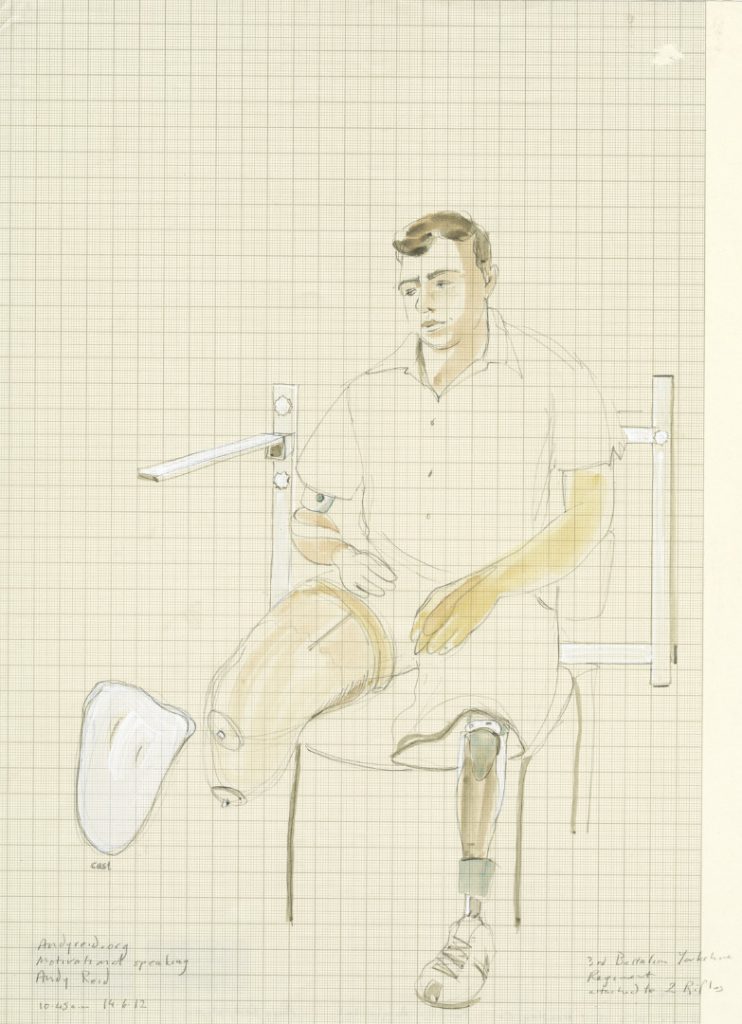
The interpretation of Tonks’ work in the exhibition War, Art and Surgery was full of personal detail, albeit with few direct quotes from the soldiers. The labels next to Midgley’s work, by contrast, were brief, and the contemporary material displayed was dominated by a surgical narrative.
There were several reasons for this. Many of the personnel had demobilised in the interim; they were no longer part of the military-medical system and were busy getting on with their lives. We cannot know whether they were happy to be framed as ‘patients’ during the rehabilitation, and then in the exhibition next to the First World War patients – but their silence indicated they may no longer have seen themselves in this light. Arguably, part of the function of Headley Court was to effect a change from amputation patient to prosthetic user. The approach soliciting feedback then came from the museum team, employees of a Royal College rather than the artist they had warmed to. In retrospect, curators could have worked more closely with Midgley and her sitters in situ while she was drawing. We could have involved elements of co-curation in the exhibition itself (Boon, 2011), as the Science Museum would go on to do with veterans living with post-traumatic stress disorder in the last section of the Wounded exhibition (Freeth, 2016). Nevertheless, at the RCS we were pleased to have represented their experience in the gallery alongside the advances in medical care and the accomplishments of surgeons. But aside from Reid’s eloquence, these prosthetic users are represented with silent dignity.
Prosthetics in Edinburgh
https://dx.doi.org/10.15180/170806/003The Royal College of Surgeons of England’s connections with prosthetic users were for the most part via the clinicians involved, on a national scale. At National Museums Scotland – largely based in Edinburgh – the links were more local, and via designers. To understand the deployment of prosthetics in our projects at National Museums Scotland, it will be helpful to outline this background.
Edinburgh’s reputation for prosthetic design emerged in the 1960s through work with children affected by thalidomide. Between 1958 and 1961 the drug was taken by thousands of expectant mothers suffering from morning sickness. It had a side effect that resulted in children born with missing or partial limbs. David Simpson, a medical physicist who developed the first foetal heart monitor in the 1950s, became director of the Powered Prosthesis Unit in Edinburgh at the Princess Margaret Rose Hospital in 1963 and was tasked with designing and building prosthetics (especially upper limbs) which could be used by children affected by thalidomide. By the end of that year the unit was serving sixty children from across Scotland and Northern Ireland (Dolan and Gow, 2013). Designing prosthetics for children was complex: they needed to be especially robust and intuitive. The team’s first outputs, the Simpson Series 1 arms, were powered by carbon dioxide, and they allowed the user to rotate their wrist and to grasp. The arms were self-levelling, which, crucially, allowed users to feed themselves. The work was unpatented and thus free for any hospital in the world to use.
The limbs Simpson and his colleagues developed had to keep up with the growth of the child as well as incorporating new technologies. ‘The children are getting older and communicating better’, he reported, ‘and our work, therefore, is improving. The children have three terribly fundamental needs to carry out on their own. To eat. To write. To go to the lavatory’ (Anon, 1964). In the late 1960s, Simpson Series 2 arms had shoulder elevation, elbow bending, grasping hand and rotations of the wrist and upper arm.
As the needs of patients changed, the Powered Prosthesis Unit at the Princess Margaret Rose Hospital went on to become the Rehabilitation Engineering Service, and still later the Southeast Mobility and Rehabilitation Technology (SMART) Centre. Engineer David Gow, director from 1993, wanted to create a modular prosthetic arm system which could be used for both arms and at different ages. At the time, many commercial components were incompatible with one another and he hoped the modular system would address the need for powered partial hands for both children and adults. Gow recognised that the pneumatic design was ‘inconvenient and cumbersome […] with limitations in functionality’ (Gow, 1999). He wanted to create a prosthetic which was lighter and more-user friendly while maintaining a modular design. In 1998, the Edinburgh Modular Arm System (EMAS), known as ‘the world’s first bionic arm’, was fitted to hotelier Campbell Aird, who had lost his arm to cancer. It weighed 1.8 kg, less than an organic arm, was battery powered and controlled by electronic micro sensors.
Although EMAS was never available commercially, the design team became Scotland’s first NHS spin-out company, Touch EMAS, later Touch Bionics, based in Livingston (outside Edinburgh). Under Gow’s leadership Touch Bionics designed their artificial hand, the i-limb. Launched in 2007, it was the first commercial prosthetic to have five individually powered fingers.
The i-limb was a flagship object for the National Museum of Scotland capital redevelopment 2012–16. The Museum’s curators had been following the progress of the Powered Prosthesis Unit and its successors. In 2008, we borrowed a first generation i-LIMB (as it was then branded) for the permanent gallery Scotland: A Changing Nation to feature in a display showing the strength and range of current scientific and technological innovation in Scotland. At the time, Touch Bionics were not ready to donate one of their few demonstration hands to the Museum, but they later transferred it to the national collection, and remain keen to provide one of their latest model for display, rather than have us include the older model.
The main strength of the National Museum’s prosthetics collection arrived in a coordinated acquisition from two sources. Some prototypes of Simpson’s work had remained with his family, and were donated to us by his son Allen D C Simpson, a former curator in the Museum; he also facilitated the acquisition of a collection held by the NHS. In all, 146 hands, arms or significant parts thereof were collected. As these had formed the makers’ research and heritage collection they had been pre-selected for survival on the basis of their design interest. Accompanying information included Gow’s recollections of what each of the items were. While patient stories were included, they were largely apocryphal and were subsumed within an overall narrative of technical innovation. For instance, we learned that maintenance of older technology endured because the prosthetists did not want to have to tell users they needed to learn to use a different limb from the one they were used to. But for the most part, like many science and technology acquisitions of this kind, we acquired the collection as evidence of technological development.
‘Reconstructing Lives’
https://dx.doi.org/10.15180/170806/004We have used these artefacts in three very different displays across two sites. We staged Reconstructing Lives: A Human Technology at the National War Museum of Scotland, located in Edinburgh Castle in 2012–13. We emphasised conflict-related amputation, including serving and veteran military personnel and civilians. The exhibition involved loans as well as the Museum’s material, and did not focus on designs which had been developed and made in Edinburgh. Rather, we traced the larger narrative of the development of the prosthetic limbs, from armour-like iron hands of the sixteenth century through to carbon-fibre running blades in the twenty-first. As far as possible we used the amputees’ own stories in the interpretation as well as the technical description of the artificial limbs. (All the prosthetic users featured had acquired rather than congenital limb loss.)
The exhibition presented several strands: the prostheses themselves; personal and technical images and video; and quotes from users and makers that were varied and sometimes contradictory. Text provided a general overview of the subject in major text panels, as well as brief vignettes of military amputees from three different centuries. More technical information about the prostheses themselves was available in the object labels. This permitted our visitors to engage with the exhibition at different levels of detail and acquire complete stories without reading all the levels of text.
The human story included a film created for the exhibition showing Chris Moon MBE talking very directly about his personal experience with prosthetics after he lost his arm and leg while clearing landmines in Mozambique, and how he went on to become an ultramarathon runner. When set alongside the story of Spitfire pilot Douglas Bader (who wore two aluminium prosthetic legs) and present-day athletes, the ‘superhuman’ narrative was clearly evident; but we were also careful to include mundane contrasts. ‘There are no superpowers in the hand’, commented Sergeant Juan Arredondo, one of the first i-limb wearers, in 2008, ‘it just makes life more normal’.[3] So too Lieutenant Dave Henson explained in 2011, ‘After being in a wheelchair it was so good to be stood up. I didn’t care if I was basically wearing buckets on my stumps’ (Thompson, 2011). We barely mentioned stories that might balance any sense of triumphalism, such as those individuals who struggle to adapt after amputation; it would in any case have been difficult to include them.
While Reconstructing Lives balanced the technological development of prosthetic limbs with the personal stories of the people who wear them, the exhibition did not present the prosthetics and personal stories together. The exhibition featured a large central showcase which enabled the prostheses to be displayed without the human context, as visually striking mechanical objects that stand on their own and speak in their own way (see Figure 6). Shown side by side the prosthetics selected for the exhibition illustrate the key developments in materials and design of this medical technology. The personal stories of wearing prosthetic limbs were presented in what we hoped was a sensitive manner, away from the prosthetics, enabling the visitors to engage easily with their human and emotional impact (see Figure 7). The human forms of these artefacts make them easy for visitors to relate to and engage with, and they had space to be considered in relation to each other. The minimal interpretation with each object provides space for visitors to consider them on their own terms.
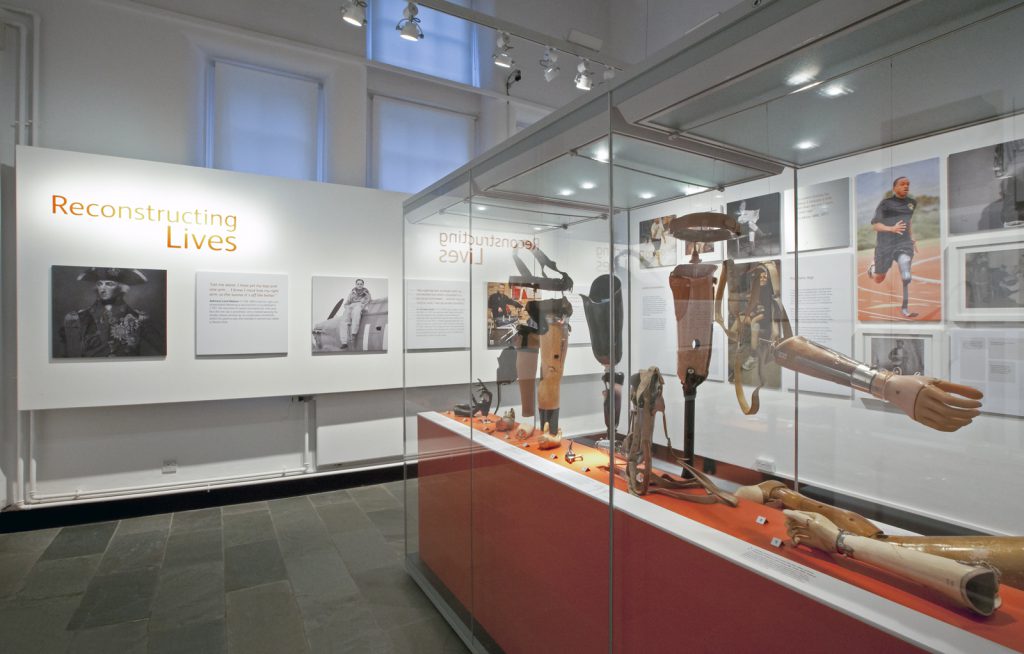

Feedback was positive, whether from general Edinburgh Castle audiences or more focused visitors, including bioengineers, therapists, military personnel and amputees. We received favourable comments about the inclusion of this topic in the context of a war museum and on the sensitivity and power of our presentation. A number reflected on the complexity of the topic, beyond the obvious horrors of war; others on how inspirational they found the featured amputees:
What a fantastic exhibition. Certainly something that has been approached in a sensitive yet positive way. More exhibitions like this should be made available for educating people!
Visitor from Newcastle, 5 June 2012
Galling and fascinating exhibition. Thank you for the time and care taken to present this record, and for the respectful way in which the exhibits are presented.
Visitor from Glasgow, 12 March 2013
Illuminating aspect about consequences of conflict, but especially excellent in raising awareness about the effort to help those who suffer amputations to continue their lives, perhaps in a new positive manner. A very innovative topic to present in a museum, which I am sure attracts a lot of interest & support.[4]
Visitor from Malta, 20 July 2012
As a representation of disability, there is no doubt that Reconstructing Lives had strong elements of a medical model: we set out to represent technical answers to practical and social needs, and to appreciate the range of solutions and innovation through the ages which has enabled people to rebuild their lives. But we took care to present these as tangible human problems, focusing on how prosthetic limbs allow wearers to accomplish things they could not do without them. The powerful relationship between user and maker was evident. Chris Moon said in the video he recorded for us, ‘Of course the fabulous people who make and provide the artificial limbs are probably the more important people in my life, because I can’t get up and get on with life and earn a living and get around if I don’t have artificial limbs’.[5]
But in this, as in all exhibitions, visitors find their own nuances:
Reconstructing Lives […] has made a permanent impression in my memory [reflected one blogger]. They examined the reality of modern warfare; life after the conflict. And, in the case of the exhibit, life with a prosthetic. There have been so many technological developments in military medical practice that more and more soldiers are surviving, while in any other period in history their injuries would have killed them. But, as the exhibit discussed, even though we can perform more complex surgeries and save more lives, the infrastructure for dealing with the lives we’ve given back is, well, a work in progress. (Victoria, 2012)
‘Shaping our World’
https://dx.doi.org/10.15180/170806/005While Reconstructing Lives was viewed within a military context in the National War Museum, other prosthetic limbs were on display in a civilian setting a kilometre away at the National Museum of Scotland. Shaping our World was a science and technology display in a Victorian wing of the Museum, with display cases in front of large wall banners. Prosthetics were chosen to feature in this gallery to showcase the recently acquired collection and because of their visual impact. One case, and the adjacent wall, presented the story of the development of upper limb prostheses in Edinburgh, from the Simpson arms to the i-limb.
The gallery opened in 2011. It was text rich, which allowed us to have four stories in this display. One described the technical challenges of designing and making a successful prosthetic limb, while the other three focused on thalidomide’s impact, the Edinburgh design work, and Campbell Aird’s EMAS. David Gow helped us, and reviewed the gallery text. In preparing the exhibition we were conscious that the engineering work which went into the limbs did not always ensure successful long-term use. The EMAS arm was a one-off which could only be maintained in use for 18 months. We used Aird’s testimony: ‘this is probably 15 or 20 years ahead of its time. It will enable me to do simple things like tie my own shoelaces instead of asking somebody to do it’ (quoted in Maguire, 1998). This was a celebratory story, from an adult who had acted as a partner in the full trial of this arm.
Not all users had such positive experiences. We were highly conscious that many children affected by thalidomide had stopped using prostheses as they moved towards adulthood (as detailed below). We considered a quote from Parliament by child psychiatrist Gerard Vaughan MP, who sat on the Thalidomide Compensation Committee and was later health minister: ‘One sees a small child coming into a room looking like a deep-sea diver dressed up in a mechanical abortion; and at the first opportunity he throws the whole lot off because he says it is intolerable to him’ (Hansard, 1972). There was understandable resistance to this tone from our stakeholders involved in artificial limb design, however, and given that the quote did not relate specifically to the work in Edinburgh, we instead addressed user rejection of prostheses in a more positive way. ‘Many of the children born without arms rejected prostheses and became skilled at using their feet’, we wrote in the gallery text, ‘though Edinburgh had a comparatively low rejection rate. This was credited to the revolutionary control system they developed.’[6]
Shaping our World did, however, result in a far richer understanding of user experience by serendipity. In 2014, we were contacted by Allan Shannon, who had been told that his picture featured in the gallery as a small boy with prosthetic arms (see Figure 8). He told us more about how much he appreciated what the prosthetic designers had been attempting to do, but also why he had stopped wearing the limbs. We have since been able to incorporate this narrative into the most recent manifestation of the permanent display, Technology by Design.
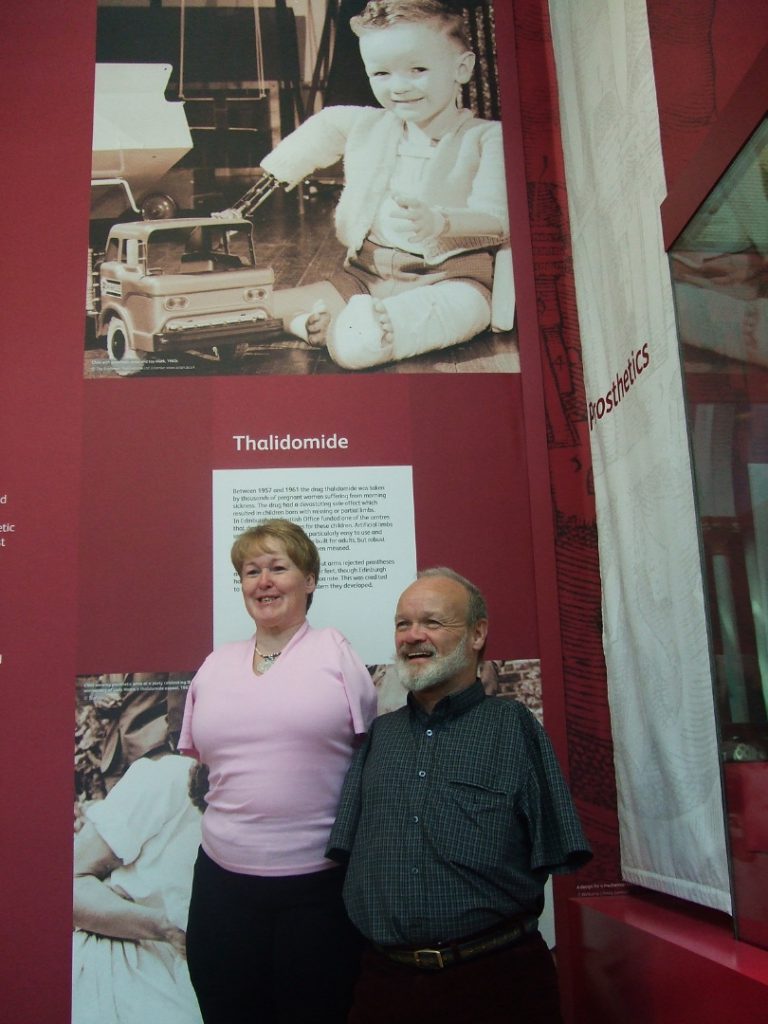
‘Technology by Design’
https://dx.doi.org/10.15180/170806/006Among the ten new galleries at the National Museum of Scotland is Technology by Design, which opened in July 2016. Located in a similar space below the previous site of Shaping our World, it once again aimed to showcase the Museum’s collection of upper limb prosthetics and Scotland’s impact in prosthetics. This time, however, we made a conscious effort to make full use of user stories alongside maker narratives.
Technology by Design as a gallery overall is overtly geared towards technical solutions to problems, from computing and sewing machines to bridges and bicycles. The ‘Engineering Humans’ section includes four tall arched cases highlighting mobility aides, devices that aid vision, upper limb prosthetics, lower limb prosthetics and artificial hips (see Figure 9). Adjacent displays exhibit wheelchairs and upright mobility, and they are supplemented with a touch table, ‘The Body Shop’, which allows visitors to touch implants such as a prosthetic testicle or a hip replacement. There is also a modern i-limb from Touch Bionics on display which is controlled by visitors via touch screen, much like the app used by wearers of the technology.
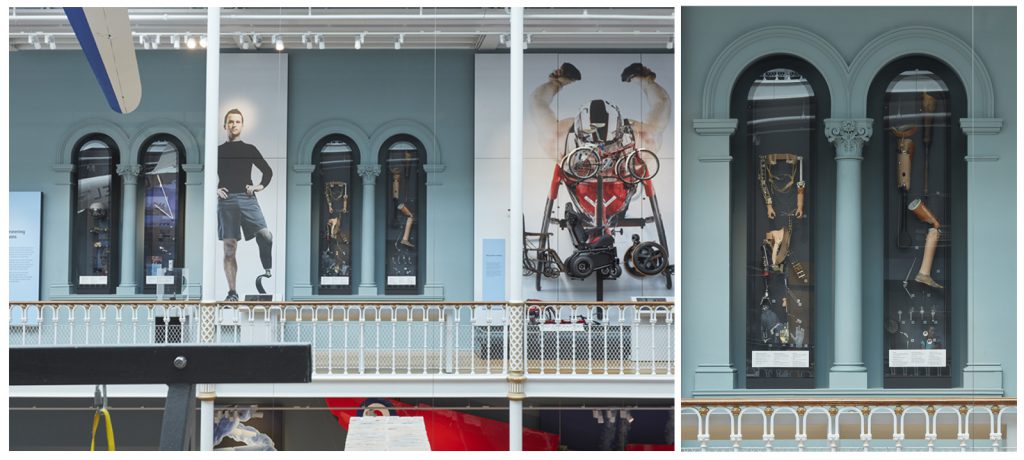
When applied to medical technology there is a danger the overall theme of the gallery – design solutions for engineering problems – would be firmly within the medical model of disability. However, we reframed this element by focusing less on the ‘fixing of a problem’ and instead on the ongoing evolution of prosthetics and the influence of the users on the design. As a result, the display of prosthetics highlights the impact of particular moments in the evolution of the designs for different users: Simpson Series 1 and 2 were designed to be fitted to children; the EMAS arm was in principle modular so it could be adapted for different needs from a partial hand to a full arm; and Touch Bionics i-limb has features like touch screen ability, which reflected its users’ specific wants and needs for controllability.
Space was particularly limited in object labels in these cases. As a result, we chose to highlight user stories on the digital screen found in the middle of the four cases (see Figure 9). It included two videos: one of a 3D printed arm inspired by Iron Man and extracts from the video of Chris Moon that featured in the Reconstructing Lives exhibition. Pictures and quotes were also used to tell the story of the work of prosthetic personalisation from the Canadian company Alleles and ‘The Alternative Limb Project’ (see Figure 1, which featured in digital content rather than as an object). The screen also gave users who chose to reject the technologies space to tell their stories in their own words.
Allan Shannon, whose image as a boy using prosthetic arms featured on the wall in the Shaping our World gallery was one of two users of the Simpson series prosthetic arms whose story featured on our digital screen. While both users had positive comments about Simpson and his team, this was ultimately a story of non-use. In Shannon’s words:
[The arms were] a godsend in certain circumstances, as they gave us an insight into being able to look a bit more like the others and also helped us reach goals and manage to do things we could and were unable to do, for example, reach places we could never reach and try and look ‘a bit more normal’ when out in the community.[7]
He eventually rejected prosthetics, however: ‘When I got into my teenage years, these arms just got in the way of life. They [were] in the way of a rough and tumble life, and also unreliable. The second user, Yvonne Kavanagh, concurred:
My recollections are the hours spent practising to do the simple tasks of lifting bricks to eating and drinking. I could feed myself and write with them too […] but my first instinct was to use my feet. […] Approaching teenage years, the arms made me ‘look normal’ but were heavy and cumbersome for my small body frame. I needed help with dressing when wearing them, but without them I could manage independently – an important factor for a teenager to be independent.[8]
By the time Kavanagh was 18 she lived without the artificial arms entirely and performed everyday tasks with her feet, which she does to this day. Such choices have also been made by other thalidomide survivors: Eddie Freeman, whose assistive technologies fitted at Roehampton are held by the Science Museum, felt a sense of liberation when he exchanged his powered legs for a wheelchair (Emmens, 2003).
We tried to communicate the range of feelings and outcomes of those using prosthetics, and visitor evaluation found that ‘The area with the wheelchairs and prosthetics conveys the message “engineering is not just about big projects it is part of everyday life and affects people’s lives”’ (Muncie and Hutcheson, 2016). Nevertheless, common responses to the displays and the accompanying digital interpretation, were (firstly) surprise, and (secondly) that the people featured were ‘inspirational’. ‘It’s amazing to see a whole area about disability featured within a museum’, was one typical example. ‘I’ve never seen that before. It’s inspirational. The people featured within the touchscreen are also inspirational. There is a young girl and I remember about thalidomide so it was interesting to see her story’ (Muncie and Hutcheson, 2016). Our efforts to display the everyday experience of a user may not have been furthered by the choice of backdrop to these displays, which featured an athlete wearing a running blade (see Figure 9).
Our findings chimed with the feedback we had from War, Art and Surgery, Shaping our World, and Reconstructing Lives, as well as other UK exhibitions. A study on feedback across nine projects co-ordinated by the Research Centre for Museums and Galleries at the University of Leicester ‘designed to offer and elicit support of new ways of understanding disability’ found that of four main forms of feedback one was that of the ‘heroic survivor’, with comments discussing the inspirational nature of those featured. However, they noted in their discussions that highlighting these ‘inspirational’ stories ‘should not automatically be avoided by museums since heroic acts are as much a part of disability history as they are mainstream history’ (Dodd et al, 2010, pp 92, 107–8).
Conclusion
https://dx.doi.org/10.15180/170806/007In their own way, we hope these projects in three museums have contributed to the uneven but welcome developments in UK museum theory and practice represented by Ryan Seary’s artificial leg (see Figure 1). Disability and disabled people are slowly featuring more, and being normalised, in a range of museum displays and programmes. Some of this has been a result of the more thoughtful activity commemorating the First World War, much of which used the past to reflect on the present. ‘Prosthetic devices’, writes curator Katherine Ott, ‘illustrate both the human cost of war and the uneasy intimacy of technology and flesh’ (Ott, 2005, p 48). Projects like War, Art and Surgery and Wounded have represented veterans with acquired disabilities, physical or otherwise. Like medical museums more generally, they move away from the unproblematic framing of those who wear prosthetics as patients, towards framing them as users. As Ott presented in her exhibition Whatever Happened to Polio? (National Museum of American History, 2005; see Sandell, 2007; Ott, 2010), they set out to present not the medicalisation of disability but the experience of use. In technology studies scholarship and museums more generally, users have a higher profile, bridging the gap between curator and visitor.
But let us not congratulate ourselves as a sector just yet. We used this article to reflect on how users were represented in our practice, and even from this partial sample of recent projects two tensions are especially evident. The first is the struggle to chart a course between the Scylla of valorisation and the Charybdis of victimhood. Although Reid, Shannon, Moon and other users perform acts every day that others might consider superhuman – few of us can use our feet so nimbly as Kavanagh – not every prosthetic user wants to run marathons or compete in the Paralympics. Conversely, neither should users be portrayed as passive recipients of medico-technical assistance. We are pleased that our visitors were inspired by the stories told in Technology by Design and the other exhibitions. But we also want to emphasise the everyday; and we maintain that this endeavour is best served by using the stories and voices of the users themselves. Future projects that follow War, Art and Surgery, which so sensitively depicted those who were learning to use prosthetics, could build in ways to capture their words. Their testimony, we argue, normalises the situation shown without distracting from the ‘stoic endurance demonstrated by injured people during rehabilitation’ (Midgley, 2014, p 284).
The second tension is especially felt by science museums, which have often played the role of shrines to the technical solution. Just as the RCS is proud of the technical development of surgery, so too National Museums Scotland rightly highlights the Scottish contribution to prosthetics. But we should not be afraid of exploring the disadvantages of technology, the problems of science, technology and medicine. Prosthetics can be liberating, but not always: Kavanagh’s and Shannon’s choice not to use the artificial limbs so painstakingly developed is an important story to tell, without diminishing the achievements of the clinicians and engineers. Just as in the nearby gallery, Energise, we present pollution alongside power generation, so too we should not shy away from the downsides and limitations of medical technology.
We should also be wary of curatorial indulgence, or overcompensation for previous interpretation. Our visitors, after all, are unlikely to be thinking of the narratives we are seeking to move away from. Many visitors appreciate the technophilic function of museums, they like to see the first, the original, the prototype. In our experience, prosthetic users are interested to see the technical development of the devices they live so closely with; and like Moon, many are intensely appreciative of the work of prosthetists. We don’t deny that inventors, scientists and doctors are important stakeholders – and they visit too. Even if the early Simpson devices were not fit-for-purpose for teenage Shannon and Kavanagh, they gave rise to the EMAS that worked for Aird. And even if EMAS was a one-off, it enabled the development of the i-limb. With care, progress narratives can be woven around and balanced by stories of users, use and non-use. Technical and human stories can be profitably and engagingly entwined. The medical model of disability is problematic, but so too is a purely social approach: amputees and thalidomide survivors do live with impairments, and for some, a technical fix is welcome. ‘If the histories of medicine, the body, and rehabilitation constitute the intellectual skin of the prosthesis’, argues Ott, ‘then surely technology contributes the scaffolding’ (2002, p 16).
These particular technical artefacts happen to be visually striking, rich in meaning from their human-like shape alone, and the cultural associations of robots, cyborgs and other humanoid machines. We are pleased to have been involved in sharing them with museum visitors – but keen that they serve to introduce more complex and layered interpretations. We have learned a lot from the clinicians, designers and users we have had the privilege to meet during these projects; and to address the question we posed at the outset, we feel we have been involved in projects that have presented balanced accounts of use and experience alongside technical and clinical narratives. But we have also shown that there remains a long way to go. Our next step is to apply this to future endeavours – and perhaps there is more work to be done with the Artificial Limb Project…
Tags
Footnotes
Back to text
Back to text
Back to text
Back to text
Back to text
Back to text
Back to text
Back to text





